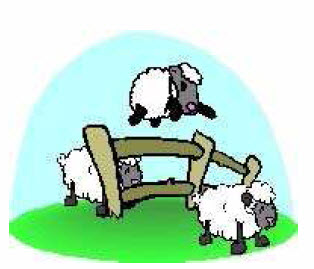HDOJ 2952 Counting Sheep
来源:互联网 发布:excel vba 连接数据库 编辑:程序博客网 时间:2024/06/06 16:47
题目链接:http://acm.hdu.edu.cn/showproblem.php?pid=2952
Counting Sheep
Time Limit: 2000/1000 MS (Java/Others) Memory Limit: 32768/32768 K (Java/Others)Total Submission(s): 2231 Accepted Submission(s): 1474
Problem Description
A while ago I had trouble sleeping. I used to lie awake, staring at the ceiling, for hours and hours. Then one day my grandmother suggested I tried counting sheep after I'd gone to bed. As always when my grandmother suggests things, I decided to try it out. The only problem was, there were no sheep around to be counted when I went to bed.

Creative as I am, that wasn't going to stop me. I sat down and wrote a computer program that made a grid of characters, where # represents a sheep, while . is grass (or whatever you like, just not sheep). To make the counting a little more interesting, I also decided I wanted to count flocks of sheep instead of single sheep. Two sheep are in the same flock if they share a common side (up, down, right or left). Also, if sheep A is in the same flock as sheep B, and sheep B is in the same flock as sheep C, then sheeps A and C are in the same flock.
Now, I've got a new problem. Though counting these sheep actually helps me fall asleep, I find that it is extremely boring. To solve this, I've decided I need another computer program that does the counting for me. Then I'll be able to just start both these programs before I go to bed, and I'll sleep tight until the morning without any disturbances. I need you to write this program for me.

Creative as I am, that wasn't going to stop me. I sat down and wrote a computer program that made a grid of characters, where # represents a sheep, while . is grass (or whatever you like, just not sheep). To make the counting a little more interesting, I also decided I wanted to count flocks of sheep instead of single sheep. Two sheep are in the same flock if they share a common side (up, down, right or left). Also, if sheep A is in the same flock as sheep B, and sheep B is in the same flock as sheep C, then sheeps A and C are in the same flock.
Now, I've got a new problem. Though counting these sheep actually helps me fall asleep, I find that it is extremely boring. To solve this, I've decided I need another computer program that does the counting for me. Then I'll be able to just start both these programs before I go to bed, and I'll sleep tight until the morning without any disturbances. I need you to write this program for me.
Input
The first line of input contains a single number T, the number of test cases to follow.
Each test case begins with a line containing two numbers, H and W, the height and width of the sheep grid. Then follows H lines, each containing W characters (either # or .), describing that part of the grid.
Each test case begins with a line containing two numbers, H and W, the height and width of the sheep grid. Then follows H lines, each containing W characters (either # or .), describing that part of the grid.
Output
For each test case, output a line containing a single number, the amount of sheep flock son that grid according to the rules stated in the problem description.
Notes and Constraints
0 < T <= 100
0 < H,W <= 100
Notes and Constraints
0 < T <= 100
0 < H,W <= 100
Sample Input
24 4#.#..#.##.##.#.#3 5###.#..#..#.###
Sample Output
63
Source
IDI Open 2009
题解:递归标记一些就好了....DFS都不用回溯。
AC代码:
#include<iostream>#include<string>#define N 105using namespace std;string str[N];int t,m,n;int dir[][2]={ {0,1},{0,-1},{1,0},{-1,0}};void dfs(int x,int y ){ for(int i=0;i<4;i++){ int dx=x+dir[i][0],dy=y+dir[i][1]; if(dx>=0&&dx<m&&dy>=0&&dy<n&&str[dx][dy]=='#'){ str[dx][dy]='.'; dfs(dx,dy); } }}int main(){ cin.sync_with_stdio(false); cin>>t; while(t--){ int sum=0; cin>>m>>n; for(int i=0;i<m;i++)cin>>str[i]; for(int i=0;i<m;i++) for(int j=0;j<n;j++) if(str[i][j]=='#'){ sum++; str[i][j]='.'; dfs(i,j); } cout<<sum<<endl; } return 0;} 0 0
- HDOJ 2952 Counting Sheep
- hdoj 2952 Counting Sheep 【dfs】
- hdoj problem 2952 Counting Sheep(深搜DFS)
- HDOJ题目2952Counting Sheep (DFS)
- HDU 2952 Counting Sheep
- hdu 2952 Counting Sheep
- hdu-2952-Counting Sheep
- hdu 2952 Counting Sheep
- hdu 2952Counting Sheep
- HDU 2952 Counting Sheep
- hdu 2952 Counting Sheep
- HDU 2952 Counting Sheep
- hdu 2952 Counting Sheep
- hdu 2952 Counting Sheep
- HDU 2952 Counting Sheep
- hdu 2952 Counting Sheep
- hdu 2952 Counting Sheep
- hdu 2952 Counting Sheep
- windows 内存泄漏检测工具vld相关
- windows上搭建mysql的主从复制测试环境
- 组合数取模
- Android SDK manager 闪退
- 翻译经典之《Cisco Lan Switching》第六章 理解生成树(四):四步比较原则
- HDOJ 2952 Counting Sheep
- Java线程学习笔记----01
- Jenkins之java servlet
- uva536 Tree Recovery
- [Unity3D]使用碰撞体做触发器实现自动开门
- windowSoftInputMode 各个值得含义
- jdbc批处理
- 翻译经典之《Cisco Lan Switching》第六章 理解生成树(五):生成树初始化收敛三部曲
- CF 245H Queries for Number of Palindromes


